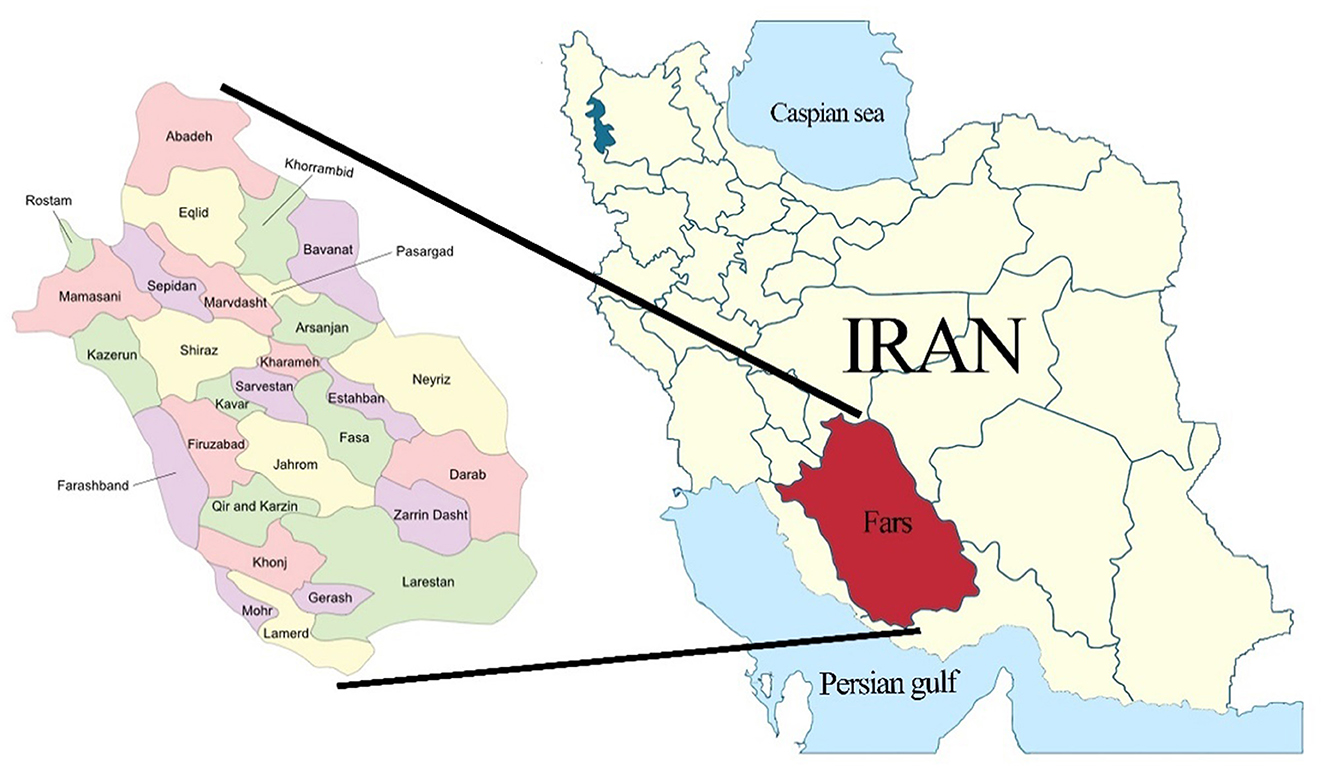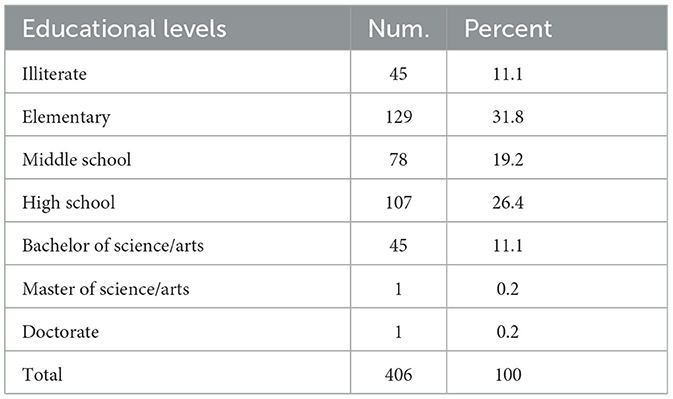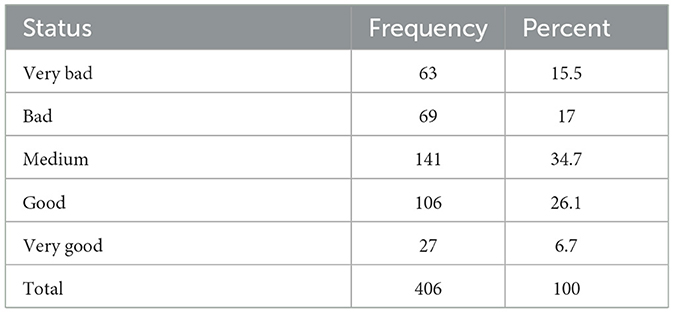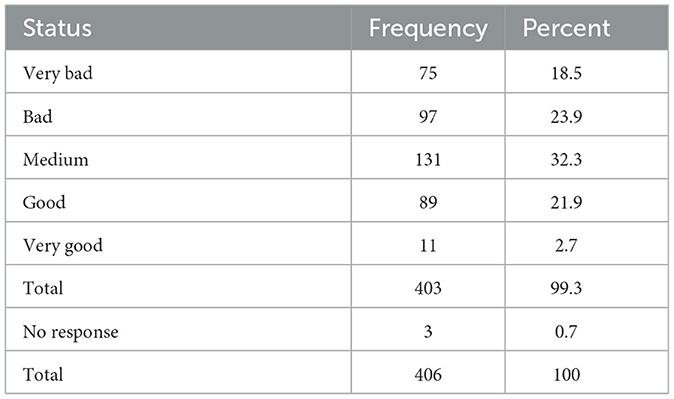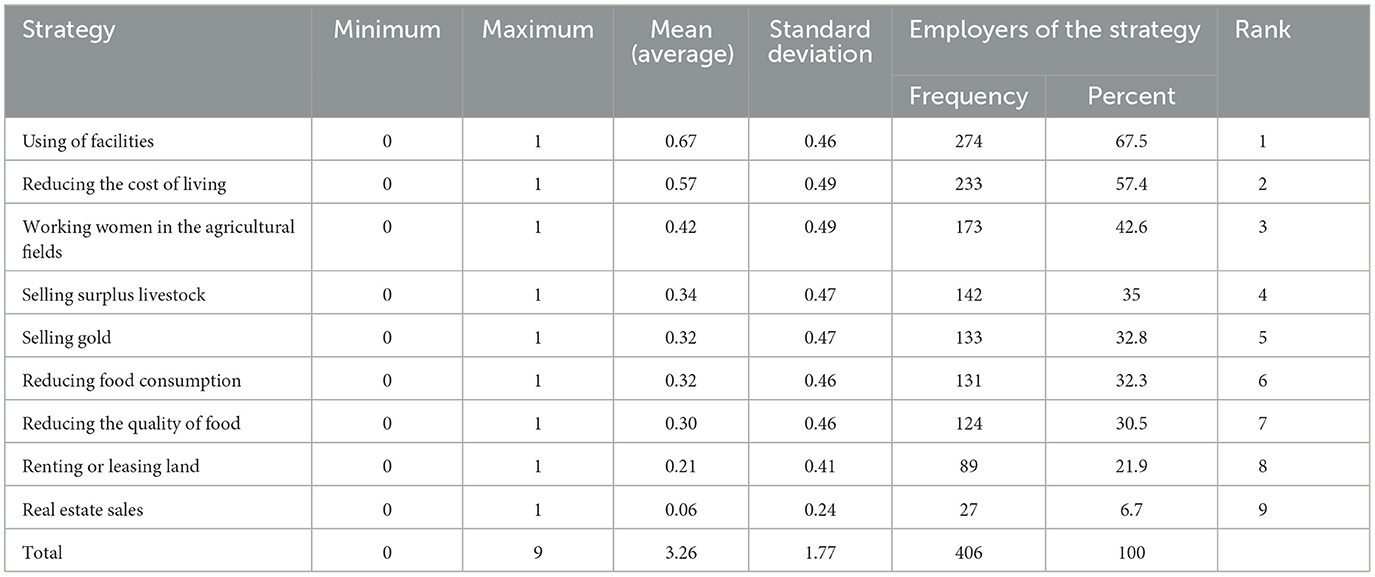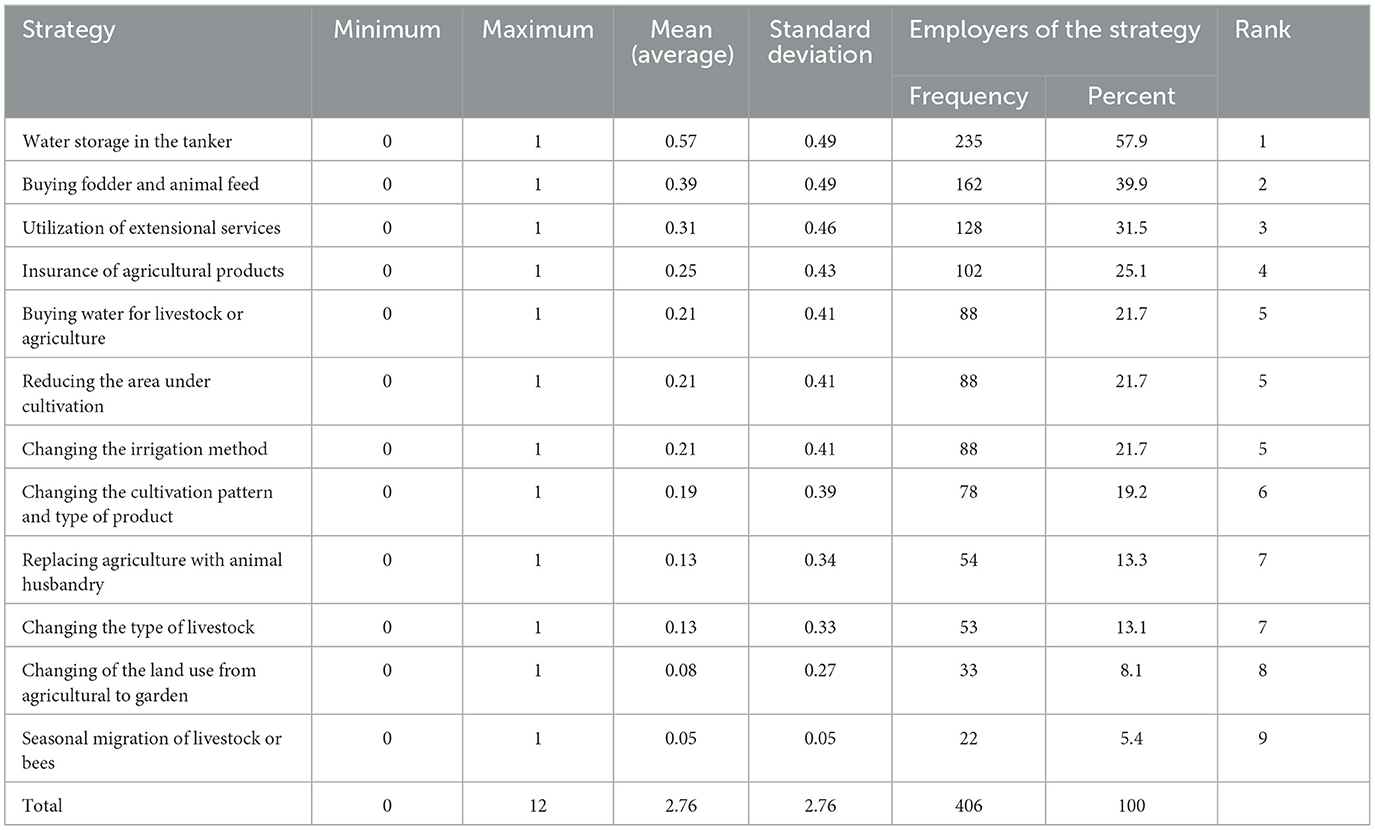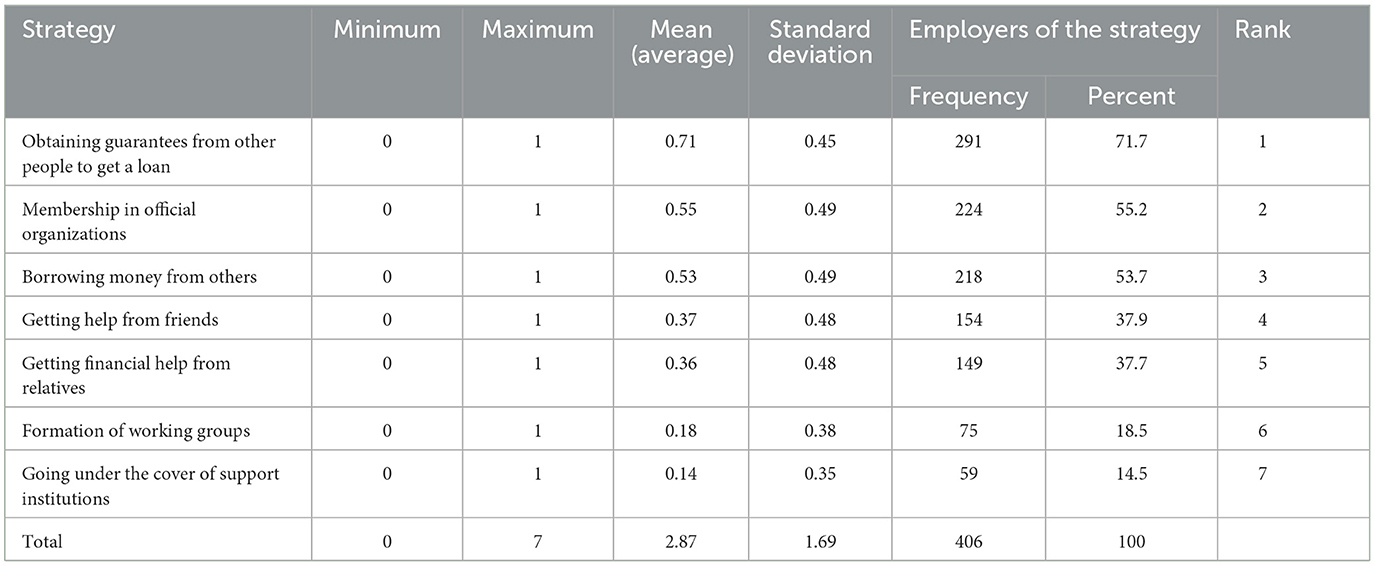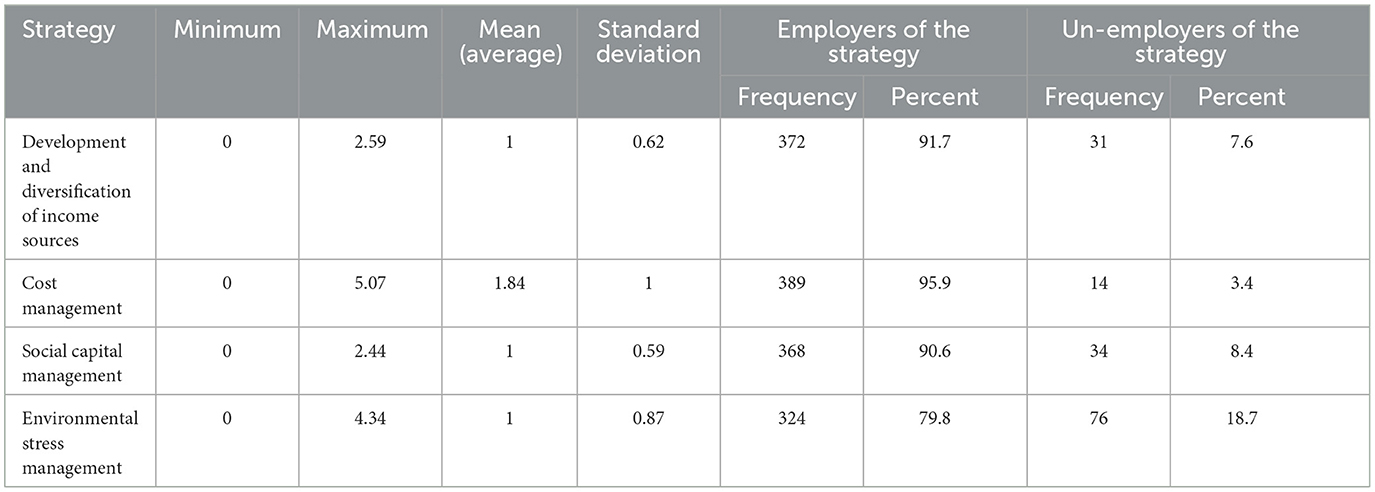- Department of Agricultural Extension and Education, Shiraz University, Shiraz, Fars, Iran
The current research aims to identify adaptation strategies adopted by rural women of Fars province in dealing with climate variability. This study is applied in terms of purpose, descriptive-correlational in terms of methodology, and field type in terms of data collection. The statistical population were rural women who were members of agricultural households in Fars province, which have been affected by climatic variability in four climatic zones: cold, mild, hot, and very hot. This study was conducted using survey method. A structured questionnaire was designed and its face and content validities were verified using experts' opinions. The size of the studied sample was estimated using Cochran's formula. For sampling, a combined stratified and cluster sampling method was used. Data were collected from 406 respondents from 32 villages in eight counties of Fars province. Then, the data was analyzed. In total, 43 adaptation strategies of rural women were classified in the form of four categories of strategies for development and diversification of income sources, cost management, social capital management, and environmental stress management. The most important adaptation strategy used by rural women against climatic changes has been the cost management strategy. The use of facilities and loans is the most important strategy among the cost management strategies that can lead to reducing the negative effects of climate variability on rural women. Then, the strategy of development and diversification of income sources, management of social capital, and management of environmental tensions were placed in the second to fourth places of adaptation strategies used by rural women under climate variability. The results of this study indicate that the rural women of Fars province are not only passive victims of climate changes, but they act actively and hope to adapt to sudden climate changes. Using prudent strategies, they employ their experience and expertise to reduce the adverse effects of climate variability.
1. Introduction
Climate change is an inevitable issue in the modern world (Memon, 2020). Basically, climate change refers to significant, long-term changes in the global climate (IPCC, 2007). Scientific research shows that human-induced climate change is a serious threat to human societies and the non-human world. However, climate variability is an issue that has major political, economic, socio-cultural, psychological, and moral consequences (Whitmarsh, 2005). Climate change and variability have a negative impact on the agricultural sector in various parts of the world, including Iran, and farmers need to be more adaptable to these changes and variability to maintain their livelihood (Azizi Khalkheili et al., 2016; Yazdanpanah et al., 2023). The scientific studies conducted in Iran also show the significant impacts of climate variability on the agricultural sector (Farajzadeh Asl et al., 2009; Khoush Akhlagh et al., 2010; Barati et al., 2023; Zobeidi et al., 2023). According to Intergovernmental Panel on Climate Change (IPCC), climate change is distributed differently among regions, generations, age groups, income groups, occupations, and genders (IPCC, 2001). Rural communities dependent on agriculture and natural resources, more than other sectors, experience the effects of climate variability (Aryal et al., 2014). Climate variability is a major threat to smallholder farmers and increases their stress in poor living conditions (Morton, 2007). There are social, technological, environmental, and economic factors that shape farmers' ability to understand and respond to climate change (Deressa et al., 2009). On the other hand, the effects of climate variability hinder development and damage human living conditions and lifestyles. This pressure is disproportionately placed on developing countries and their poor. As a result, inequality in health status and access to adequate food, healthy water, and other resources intensifies (Roehr, 2007).
In addition, climate variability does not affect individuals and groups alike (Goli et al., 2023). Disasters and their associated impacts often exacerbate existing inequalities, vulnerabilities, economic poverty, and unequal power relations (Brody et al., 2008). Men and women in different situations perceive and experience climate variability in different ways. Because gender roles, responsibilities, positions, and social identities lead to different coping strategies and responses (Lambrou and Nelson, 2010), the term adaptation to climate variability is the modification of natural or human systems in response to real or expected climatic shock. These effects mitigate the damage or take advantage of opportunities to increase the system's resilience to climate change (IPCC, 2007). Adaptation is not an independent process. In other words, adaptation depends on the role and influence of various geographical, ecological, socio-economic, cultural, political, and institutional factors, each of which independently and/or collectively affects the human environment (Ndaki, 2014). It is often argued that people's perceptions of climate Variability and how to adapt to it is economically, socially, and environmentally an important factor in improving their livelihoods through adaptation approaches (Ganesh, 2021).
Gender, education, non-agricultural activity, farm size, ownership of assets, access to credit, and access to information on climate variability are among the determinants of adaptation to climate variability (Lemma, 2016; Tesfaye and Seifu, 2016). Disasters affect men and women in different ways. Accordingly, their impacts are greater on some groups such as women and children (Fitriani et al., 2019). The effects of climate variability vary due to the vulnerability levels of different groups. The poor, women, and children are among the most vulnerable to the impacts of climate variability (McKinley et al., 2016). But the key question in this regard is why gender is an important factor in the discourse of climate variability and especially in adaptation to climate variability? Gender and adaptation to climate variability have complex relationships. Therefore, it is argued that the interaction between gender forms of knowledge, power, and decision-making requires a subtle perspective (Bhattarai et al., 2015). Men and women have different roles, responsibilities, and decision-making power, which harms women. Therefore, it is not surprising that gender also plays a role in adapting to climate variability. Women and men (in their particular social roles) are affected differently by climate change. These differences are generally due to reasons such as having different responsibilities (taking care of children and earning), lack of proper access to services, inequality in access to knowledge and capacities to deal with risks, and inadequate access to proper training. The social roles and responsibilities of women and men lead to different degrees of their dependence on the natural environment. Factors such as economic weakness, lack of access to resources and information, dependence on men, and lack of decision-making power result in the deterioration of the condition of women (as a vulnerable group) (Roehr, 2007). Due to their high dependence on natural resources, this group is more vulnerable to the effects of climate change than other groups (Mzimela, 2017). They account for a larger percentage of the world's poor, and although they are actively involved in agricultural work, their role is neglected. In many cases, women also have to provide food security for the family and carry heavy loads in order to provide the water and fuel they need. More specifically, it should be stated that many poor women rely on natural resources for their livelihoods, which are under serious threat (UN Women Watch, 2009). Moreover, they have unequal access, control, and ownership of these natural resources. They are often excluded from important decision-making and policy-making bodies and institutions that govern them (Zhongming et al., 2011).
Men and women are different in terms of their perceptions and responses to climate variabilities. This problem demands that special attention be paid to the status of different gender groups in plannings related to adaptation to climate variabilities (Roehr, 2007). Age, education, agricultural experience, land rights, women's empowerment, livestock ownership, and changes in rainfall are very important factors that can be effective in choosing women's coping strategies against the negative effects of climate change (Batool et al., 2018). Climate variabilities may exacerbate gender inequality and create additional responsibilities for women. This can increase the vulnerability of women in poor families (McKinley et al., 2016). Studies show that women's vulnerability to climate changes is evident in many parts of the world. One of the most important reasons for this is related to their less access to education and information. Meanwhile, the existence of such information can help them in managing the risks related to climate change; therefore, agricultural activities and food security are also less damaged (Jost et al., 2015). The social role of women in many countries can also limit their ability to adapt to climate change. This increasing sensitivity to climate change is the result of women's household responsibilities such as child care, water supply, providing fuel for cooking, and their increased responsibility in agricultural production (FAO, 2011; McKinley et al., 2016).
Adaptation is a complex and often costly process that covers many human, economic, and environmental issues (Karimi et al., 2022). According to what was mentioned earlier, adaptation can have gender characteristics in some cases. In such cases, the term gender-based adaptation is used. At the core of this form of adaptation lies a wide range of inequalities in age, class, and gender, which are related to the impacts and responses to climate variability. These inequalities create the ground for reducing individual adaptation capacities, which should be taken into consideration when formulating policies (Ylipaa et al., 2019). It can be argued that adaptation is a learning process. Therefore, to achieve success in this learning style, elements including policies, programs, and practices must be continuously monitored and reviewed (Hinkel et al., 2009). Adaptation strategies should reduce the potential negative impacts of climate variability. These strategies should improve the welfare of households in the short term and achieve development goals (Figueiredo and Perkins, 2013). Developing an appropriate adaptation strategy to deal with the negative consequences of climate variabilities can improve women's productivity and financial stability (Parry et al., 2007). The formation of appropriate knowledge resources in the field of adaptation methods and factors affecting the selection of adaptation strategies by rural women helps to design policies to deal with the challenges that climate Variabilities create on rural women.
Various studies have been conducted on farmers' understanding and selection of adaptation strategies in different countries (see Tesfaye and Seifu, 2016; Karimi et al., 2020; Abedi et al., 2022; Valizadeh et al., 2022). However, most of them have addressed this issue at the macro level. Therefore, they cannot be generalized to poor women living in specific places (Tazeze et al., 2012). In general, the issue of gender and climate variability adaptation is under-researched, and for many people, understanding the ways in which gender may be a factor in climate change adaptation and how it should be addressed politically is difficult. Gender aspects are rarely considered in climate change policies. At the same time, the participation of women in adapting to climate variabilities is very important. Because, women generally have valuable local knowledge that they can share when making decisions about adaptation to climate variability, and use this knowledge as a basis for designing context-specific adaptation strategies (Figueiredo and Perkins, 2013). The requirement of any planning on climate variability is that there is a comprehensive insight from the local people's point of view about changes in temperature and precipitation and climate variability in general (Cherinet and Mekonnen, 2019). Women's adaptation strategies to climate variability have the potential to significantly help reduce the negative effects of climate variability (Tesfaye and Seifu, 2016). In this regard, identifying the adaptation strategies of rural women members of agricultural households against climate variability was chosen as the main goal of this research. The results of this research can be very useful for rural women and local governments in understanding the current events caused by climate and its risks on their livelihoods and adaptive capacity.
The Intergovernmental Panel on Climate Change (IPCC) defines adaptation as the compatibility and adjustment of natural or human systems in response to real or predicted climate stimuli and their impacts. According to this definition, adaptability moderates the negative impacts and makes successful use of opportunities (IPCC, 2007). Adaptation has historically been a marginal policy option for climate change. Considering adaptation as a marginal policy has led to the development of poverty in many countries (Ayers, 2010). The adaptation process depends on the adaptive capacity of the system and people. Adaptation capacity is the ability to prepare, facilitate, and implement adaptation measures or the ability to absorb and withstand the impacts at any particular time (Ndaki, 2014). Adaptive capacity includes a wide range of factors including wealth level, technological capacity, timely access to information, having key skills, infrastructure, existence of institutions, social capital, and justice (Vincent, 2007).
Tembo (2013) in his research on the adaptive capacity and access to resources and power states that adaptive capacity occurs using a complex network of relationships that have consequences at the individual level. Adaptive strategies are based on how to use local knowledge about water, stakeholder cooperation, and livelihood diversification. Specialization and diversification of livelihoods are important elements in reducing vulnerability to climatic changes (Eriksen et al., 2005). Especially, in rural and agricultural areas, diversification of livelihoods is considered an important factor to prevent vulnerability. Adaptation strategies are different both in terms of efficiency and potential climate risk, but the adoption and careful use of appropriate adaptation strategies can be useful in the efficient allocation of resources (Ncube et al., 2016). Since women and men experience climate variability in different ways and have different social roles, responsibilities, positions, and identities, adapt strategies and different reactions to climate variability (Lambrou and Nelson, 2010). Therefore, the ability to adapt is closely related to gender, and it is necessary to identify the different strategies that women use to adapt to climate variability. Identifying these strategies can lead to the formulation of appropriate policies and programs for women's adaptation to climate variabilities.
2. Material and methods
2.1. General perspectives of the research method
This research is applied in terms of purpose, descriptive in terms of methodology, and field type in terms of data collection method. The statistical population of the research was all rural women of Fars province who were affected by climatic Variabilities. In this research, a cross-sectional survey was used with the aim of identifying the adaptation strategies of rural women in Fars province to climate Variabilities and water scarcity. Rural women members of farmer households in Fars province have been affected by climate Variabilities in four climatic zones: cold, moderate, hot, and very hot. Therefore, the statistical population included rural women who were in these four regions. Both primary and secondary data sources were used to collect data. Primary data are data that were collected directly through interviews or questionnaires. The secondary data included the data collected from the meteorological database and the management and planning organization of Fars province.
2.2. Study site
Fars province is the second producer of agricultural products located in the south of Iran (Figure 1). With an area of 12,2000 more than 122,000 square kilometers, this province constitutes 7.5% of the area of Iran. Fars province is geographically spread from 42°50 to 36°55 east longitude and 27° to 31° north latitude. In terms of country divisions, this province is divided into 36 counties and sub-counties (Management and Planning Organization of Fars Province, 2019). In terms of natural location, Fars province is mostly mountainous, and according to the surveys, 34.7% of the province is plains and flat areas, and the remaining 65.3% is highlands. Due to its vastness, Fars province has different ecosystems. The existing geographical diversity has caused significant changes in the level of precipitation and different climates are formed in the province. In terms of weather conditions, Fars province has four seasons. The northern part is cold, the center is moderate, and the south is hot and very hot.
The average long-term rainfall in different regions of Fars province varies from 188 to 833 mm. The rainfall of the province in 1996 was 285 mm, which indicates the 10-year drought in Fars province (Table 1).
The agricultural sector of Fars province plays an essential role in ensuring food security, production, and employment of the country; so that 10% of the country's production, 9.2% of the added value of the country's agricultural sector, 23% of the added value of the province's economic sectors, and 20.6% of the province's employment are related to the agricultural sector. In Iran, climatic changes often appear in the form of drought. According to the report of the Meteorological Organization of Iran, in a period of 120 months, 88.3% of the area of Fars province has been affected by severe and very severe drought. In addition, 11.4% of the province experienced moderate drought and 0.3% mild drought (Meteorological Organization of Iran, 2017). It should be noted that the drought has had a negative effect on the production of agricultural products in this district. For example, the research of Khoush Akhlagh et al. (2010) showed that due to the drought, the amount of wheat harvested in Marvdasht county was reduced by 38.3% compared to the previous year.
2.3. Population of the study
The studied population were rural women members of agricultural households in Fars province, which are affected by climatic changes in four climatic zones: cold, moderate, hot, and very hot. According to the census of 2015, Fars province had a population of about 4,851,274 people, of which 29.53 % (1,432,355) is the rural population, among which, the population of rural women aged 10 years and older is 572,486 cases. In addition, the economically active population of rural women is 10.8% (Management and Planning Organization of Fars Province, 2019).
2.4. Data collection tool in cross-sectional survey
A structured questionnaire was used to identify and apply adaptation strategies of rural women against climatic variabilities. The face and content validity of the questionnaire was confirmed by the experts of agricultural extension and education, experts of the Jihad Agricultural Organization, and experts of climate change studies. The reliability of the research tool was assessed using Cronbach's alpha after conducting a pilot test in region outside the study area. Cronbach's alpha coefficients were greater than 0.7 for the constructs being measured using Likert scale. After collecting the required information, the data was entered into SPSS24 software and analyzed.
2.5. Sampling
In order to select the studied samples, the counties of Fars province were divided according to the type of climate they had (cold, moderate, hot, and very hot) and the level of drought they had experienced (mild, moderate, severe, and very severe). After that, the studied counties were determined based on the distribution of the type of drought in different climates. All the counties of Fars province have been affected by drought.
In this research, a integrated stratified and cluster sampling method was used. For the classification of community units, the climate variable was considered as a criterion that depends on the attribute of the investigated variable, i.e. climate variability (Table 2). Therefore, the samples were selected from all four climates: cold, moderate, hot, and very hot. Two counties from each climatic region, two sub-counties from each county, and two villages from each sub-county were selected. Finally, rural women were randomly selected.
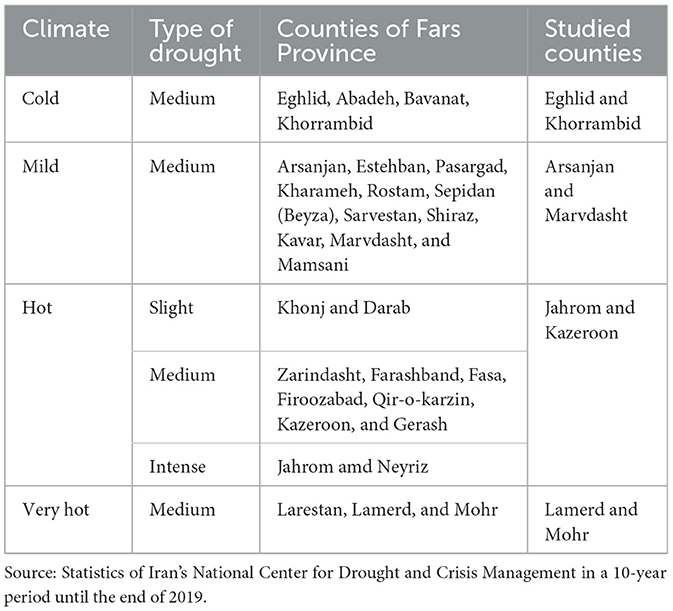
Table 2. Classification of the counties of Fars Province according to the type of drought experienced in the climatic regions.
Cochran's formula was used to calculate the sample size.
n = Statistical sample size
N = The size of the statistical population
d = Permissible error (usually considered equal to 0.05)
z = Value of normal variable with confidence level 1- α. In the two-domain test, the z value for the 95% confidence level is 1.96 and for the 99% confidence level it is 2.58.
p = the proportion of possession of the desired trait
q = (1-p) = Refers to the possibility of not having the desired attribute (for example, the female population). p and q are usually considered 0.5.
Based on Cochran's formula, the calculation was done with an error level of 5%. Considering that 572,486 women of Fars province were more than ten years old, the sample size was estimated to be 384. To reduce the sampling error (that is, the difference between the parameter value in the population and the statistic value in the sample), increase the generalizability, and achieve a more accurate estimate, 10% was added to the sample size. Therefore, a total of 420 rural women were selected from the study area. Of these, 14 questionnaires were incomplete and discarded.
2.6. Conceptual and functional definition of adaptation strategies
Conceptual definition of adaptation strategies: These strategies are actually strategies for adjusting the effects of climate Variabilities, which are used by the rural women under study. Based on the primary exploratory study, a set of these strategies was extracted and then 43 adaptation strategies were divided into four categories of strategies for development and diversification of income sources, cost management, social capital management, and environmental stress management.
2.6.1. Operational definition of adaptation strategies
This variable was asked using questions on a nominal scale about the application of adaptation measures. The composite index related to the four categories of adaptation strategies of rural women, after fixing the difference in scale and weighting, was calculated using the following formula:
AS = Rural women's strategy in adapting to climate Variabilities
ADRe = The strategy of development and diversification of income (fixed the difference in scale)
ACMe = Cost management strategy (fixed the difference in scale)
ASCMe = Social capital management strategy (fixed the difference in scale)
AMESe = Environmental stress management strategy (fixed the difference in scale)
Wa1= The weight of the strategy of development and diversification of income sources
Wa2= The weight of cost management strategy
Wa3 = The weight of social capital management strategy
Wa4= The weight of environmental stress management strategy.
3. Findings and discussions
3.1. Demographic characteristics of the studied rural women
In terms of the gender of the head of the household of the participants, 34 (8.4%) were female and 372 (91.6%) were male. The average age of the researched samples showed that their average age was 41.27 years with a minimum of 16 and a maximum of 73 years. In terms of the educational levels of the studied rural women, 11.1% were illiterate. In addition, 31.8% had primary education degree, 19.2% had secondary education degree, 26.4% had high school education degree, and about 11.5% had university education degree (Table 3).
The results related to the survey of rural women's income sources showed that most of them (67.5%) earn income from processing agricultural products. Also, the processing of agricultural products had the highest average among income earning strategies. This strategy, with an average of 6.6 million tomans and a standard deviation of 7.9, had a greater role than other variables in the income of rural women. Then, service-based activities with an average income of 6.2 million tomans and a standard deviation of 15.3 were ranked as the second most important sources of income for rural women. It should be noted that handicrafts (such as carpet weaving, sewing, carpet embroidery, and etc.) with an average income of about 3 million Tomans and a standard deviation of 5.6 and working in other people's agricultural farms with an average 2.5 million Tomans and a standard deviation of 5.3 were placed in the next place of the income-earning strategies of the rural women participating in this study (Table 4).
The participation levels of rural women in earning household income were statistically different; so that 75% of the respondents stated that up to 25% of the household income is the result of their work. About 21% mentioned that they provide between 26 and 50% of the household income. Nearly 2.5% of the respondents provided more than half of the household income.
3.2. Impacts of climate variabilities on the agricultural water
Among the most important impacts of climate variability and drought, we can mention changes in the quality and quantity of agricultural water resources. According to the results of this study, 32.5% of rural women have evaluated the quality of their agricultural water as bad or very bad, which includes the saltiness and bitterness of agricultural water (Table 5).
42.4 % of the respondents rated their access to agricultural water sources as bad and very bad, which indicates the lack of water for agriculture. These respondents constituted a significant percentage of the respondents, which shows the water crisis in agriculture in Fars province (Table 6).
3.3. Adaptation strategies
Adaptation strategies are strategies to adjust the impacts of climate variability, which are used by rural women. Based on the results of various studies, a set of these strategies was extracted and then 43 adaptation strategies were divided into 4 categories of strategies for development and diversification of income sources, cost management, social capital management, and environmental stress management. Exploratory factor analysis has been used to divide these strategies. The descriptive results of each category of strategies are given below.
3.3.1. Strategies related to development of diversification income sources
A total of 14 strategies were proposed in the form of nominal questions “yes,” “no,” and “no case.” Based on the means' comparison, in the category of development and diversification of income sources, strategies including development of complementary agricultural activities (including the sale and processing of agricultural products), rural women working to earn money, increasing the amount of work, working in non-agricultural activities (service jobs such as hairdressing, school services, assembly services, shopkeeping, and handicrafts), and poultry farming were used by rural women more than other strategies. Other strategies of this group are also presented in Table 6. As can be seen, more than 61 % of the studied rural women process agricultural products and sell them in order to develop household income sources, so that through the added value of agricultural products, they can compensate for the damages caused by climatic changes. Also, more than 50 % of rural women in this research had to work to earn money or do more heavy work than they could.
3.3.2. Costs management strategies
This strategy was asked with 9 items in the form of nominal closed questions. In this category, using facilities with a mean of 0.57 and a standard deviation of 0.49 was the most important cost management strategy used by rural women. This result is consistent with the results of Obayelu et al. (2014). Reducing the cost of living and working in the farm for rural women has been one of the other cost management strategies of rural women in adapting to climate changes. The strategy of selling surplus livestock, selling valuable assets (such as gold) were other adaptation strategies to compensate for the deficit of household income in the conditions of climate change. These results are consistent with the results of Abedi et al. (2022), Karimi et al. (2022), and Goli et al. (2023). More than 30 % of the respondents mentioned that reducing the quantity and quality of food is a solution to adapt to the harsh conditions of climate change (Table 7). Cost management strategy with the mean of 3.26, standard deviation of 1.77, minimum of 0, and a maximum of 9 (range between 0 and 9) has been used by rural women of Fars province.
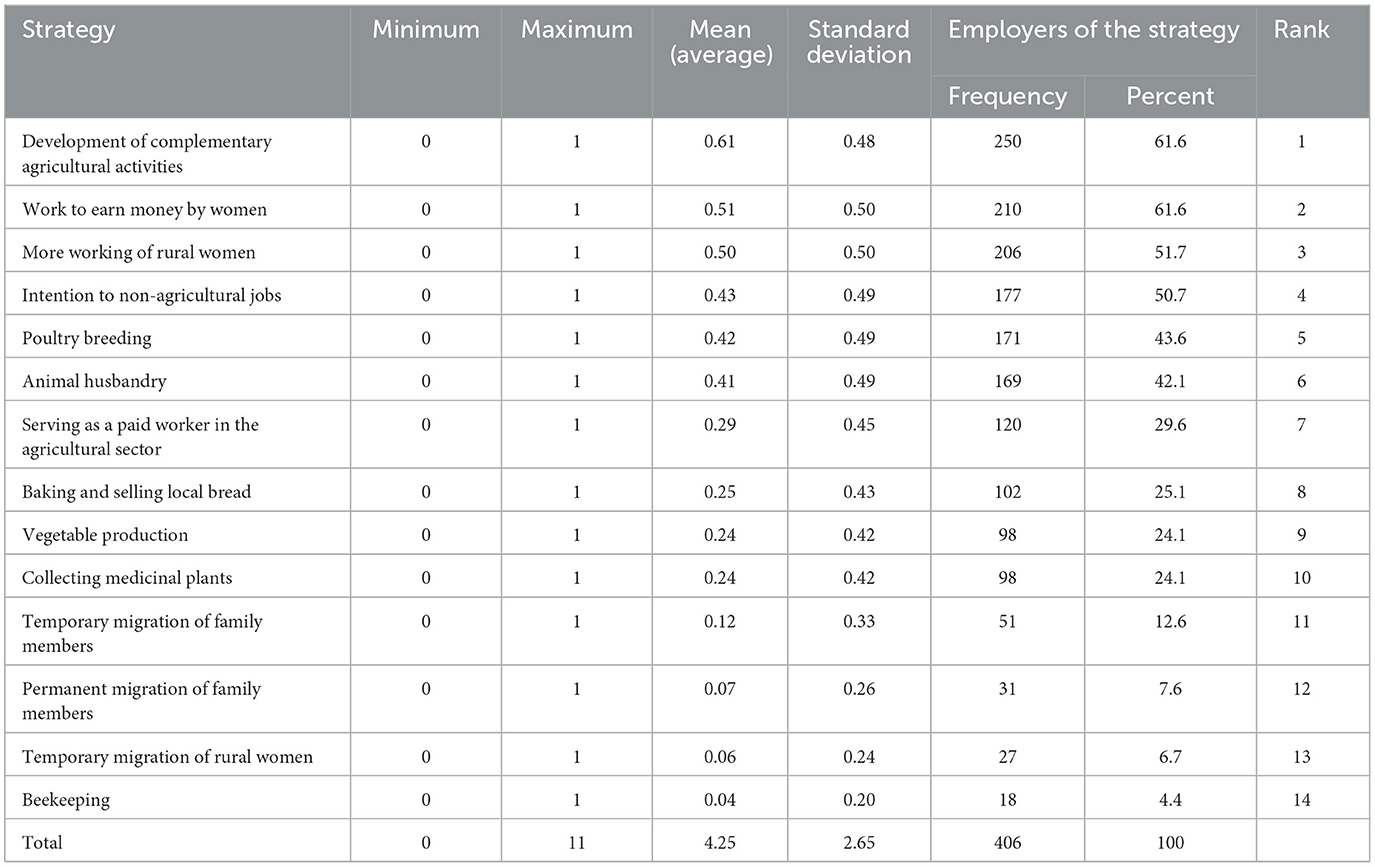
Table 7. Application of the strategy of development and diversification of income sources by the respondents.
3.3.3. Social capital management strategy
In the category of social capital management strategies, 7 strategies have been proposed. Based on the findings of this study, the most important social capital management strategy used by rural women in order to adapt to climate variability was getting guarantees from other people in the rural community. This was done in order to get a loan. This strategy has the mean of 0.71 and a standard deviation of 0.45, which means that more than 71 % of the respondents mentioned that they use this strategy. The second strategy to adapt to climate changes in the social capital management strategy is women's membership in formal social organizations such as microcredit funds, cooperatives, and social organizations. This strategy had the mean of 0.55 and a deviation of 0.49, and more than 55 % of the rural women studied in this research stated that they use this strategy (Table 8). Similar findings can be found among the results of Karimi et al. (2022) and Abedi et al. (2022). The category of social capital management strategies had the mean of 2.87, standard deviation of 1.69, minimum of 0, and a maximum of 7. It should also be mentioned that the range was between 0 and 7.
3.3.4. Strategy related to environmental stress management
To evaluate the use of strategies related to the management of environmental tensions by rural women, 12 strategies were proposed (Table 9). According to the results, in order to adapt to the climatic variabilities, the rural women of Fars province mostly used the strategy of storing water in the tanker in the category of strategies related to the environmental stress management. This strategy had the mean of 0.57 and standard deviation of 0.49, and nearly 58 % of the participants in this study had used this strategy. The lack of fodder caused by drought in the conditions of climatic changes has been compensated by using the strategy of buying fodder and animal feed. This finding is in line with the findings of Abedi et al. (2022). Also, more than 31 % of the respondents used educational-extensional and consulting services in order to increase their knowledge and skills to adapt to climate variabilities. Table 10 shows the extent of using strategies related to environmental stress management.
3.4. Evaluation of adaptation strategy
Examining the mean and frequency of rural women in using the categorized strategies shows that strategies related to cost management are used by 95.9% of the respondents (Table 11). Then, the strategies related to the development and diversification of income sources, management of social capital, and management of environmental tensions are placed in the second to fourth place of adapting to climate variabilities, respectively. These results indicate that the rural women of Fars province are concerned about environmental issues and support policies related to environmental restoration. This result is consistent with the results of Yadav and Lal (2018).

Table 11. Comparison of the mean the use of adaptation strategies in different climatic zones of Fars province.
In order to determine the composite index of the adaptation strategy of rural women, first the adaptation strategies were fixed in order to remove the scale difference and then the weighting was done based on the principal components. In this method, a factor analysis using principal components approach was carried out to determine the weights of the strategies. In principal component analysis, the average variance explained by each component is considered as the weight of that component (strategy). The composite index was calculated using the following formula:
AS = Rural women's strategy in adapting to climate variabilities
ADRe = The strategy of development and diversification of income (fixed the difference in scale)
ACMe = Cost management strategy (fixed the difference in scale)
ASCMe = Social capital management strategy (fixed the difference in scale)
AMESe = Environmental stress management strategy (fixed the difference in scale)
Wa1= The weight of the strategy of development and diversification of income sources= 0.749
Wa2= The weight of cost management strategy= 0.776
Wa3 = The weight of social capital management strategy= 0.512
Wa4= The weight of environmental stress management strategy: 0.790
The adaptation strategy of rural women had the mean of 3.46, standard deviation of 1.64, minimum of 0.18, and a maximum of 8.51 (the range was between 0 and 9.29).
3.5. Comparison of the usage mean of adaptation strategies in different climatic of Fars province
The spatial analysis of the use of adaptation strategies in different climatic zones has been presented in Table 12. Climatic zones were different in terms of usage of the adaptation strategies including environmental stress management strategies, cost management strategies, and development and diversification of income resource. However, no mean difference was observed regarding the use of social capital management strategy among different climatic zones. With the mean of 2.77 and a standard deviation of 1.49, the level of employing adaptation strategies in the cold climatic zone was lower than the other three zones. Cold climatic zones were not different from mild and very hot climatic zones in terms of applying the strategy of development and diversification of income sources. Nevertheless, the level of using this strategy in the cold climatic zone was significantly different from the hot climatic zone.
4. Conclusions and recommendations
To reduce gender vulnerability to climate variabilities, adaptation responses should consider environmental conditions and social changes. Targeting women in adaptation processes and discourses that introduce women as “main victims” in this context, helps to reduce their vulnerability. According to the results, in the category of strategies for development and diversification of income sources, more than 61% of rural women used the strategy of processing agricultural products and selling them. In fact, on average, rural women have used more than four adaptation strategies related to the category of development and diversification of income sources. More than 50% of the rural women in this research had to work to earn money and even in some cases did more work than they could. Men have been forced to migrate due to climate variability and the lack of livelihood resources in rural areas, and this factor has made women's responsibilities heavier. In recent years, due to drought and climatic variabilities and as a result migration of men, agricultural activities in rural areas have moved toward “feminization.” This has increased the workload of women. There is a lot of evidence from the study areas that show that women's responsibilities have increased due to climate variabilities and they have to work more to provide their livelihood. Economic difficulties have also made women more vulnerable to issues such as loss of livelihood resources, limited access to resources for adaptation, and male migration. In this regard, it can be recommended that the development of agricultural value chain activities can help to increase and diversify the income sources of rural women. Also, the establishment of semi-mechanized agricultural products processing workshops can also help to increase the added value of agricultural products and prevent the sale of agricultural products raw by women.
The most important adaptation strategy used by rural women against climatic variabilities has been the cost management strategy. Using facilities and loans is the most important strategy (in the category of cost management strategy) that can lead to reducing the negative impacts of climate changes on rural women. Considering free and low-interest and/or long and easy repayment loans for rural women members of rural households can make them more adaptable in facing drought conditions and climatic changes. In the context of applying the strategy of environmental stress management, we can highlight the strategy of storing water in the tanker for household use, which nearly 58% of the participants in this study used this strategy. Women have also been able to solve the problem of fodder shortage caused by drought in climatic changes through the strategy of buying fodder and animal feed. Therefore, the creation of livestock cooperatives in order to provide livestock inputs and the government's support to rural women farmers through the provision of livestock inputs, especially animal feed (using credit cards), can be effective in their adaptation to climate changes and sustainability of production practices. Also, more than 31% of the respondents have used educational-extensional and consulting services in order to increase their knowledge and skills to adapt to climate changes. Creating websites to share the successful experiences of rural women in adapting to water shortage conditions and climatic changes and developing extension training for rural women will help to improve their knowledge in the field of adaptation.
In evaluating and comparing the types of strategies used by rural women participating in this study, cost management strategy was the most important category of strategies. Then, the strategies of development and diversification of income sources, management of social capital, and management of environmental tensions were placed in the second to fourth place of adaptation strategies used by rural women, respectively. The results of present study show that the rural women of Fars province are not only passive victims of climate changes, but also actively act and hope to adapt to sudden climate changes. Using prudent strategies, they use their experience and expertise to reduce the adverse impacts of climate changes. They are also concerned about environmental issues and are very supportive of environmental restoration policies. But there is evidence of gender bias in the process of policy adaptation, development, and implementation. Gender inequality is a major factor in vulnerability to climate change, and for this reason, it must be addressed in adaptation responses. However, such work should be done through feminist analytical tools that show gender relations as dynamic and changeable.
In order to adapt to climate changes in the category of social capital management strategies, adaptive responses such as the membership of rural women in formal social organizations (such as microcredit funds, cooperatives, and social organizations accepted by rural women) have been emphasized. Therefore, it is suggested that these organizations and cooperatives can be considered as a financial source in improving the adaptation capacity of rural women against the harsh conditions of climatic changes. Rural women face many administrative problems in terms of access to economic institutions such as banks due to economic and social gender inequalities and lack of valid collateral and guarantee. Therefore, they have less facilities than men in terms of capital, credit, and power. The low level of capital and assets leads to less adaptive capacity and as a result, their greater vulnerability. Therefore, it is suggested to develop some popular socio-economic organizations such as special credit funds for rural women. These organizations can be a key strategy for access to financial resources and credits is for rural women, especially for clusters with greater vulnerability, which can provide access to financial resources for their adaptation measures and reduce their vulnerability against climate change. The adaptability of rural women means empowering women to play a prominent role in development and their active participation in decision-making, which is one of the necessities of achieving sustainable development. The development of rural women's microcredit funds is another recommendation of present study that will lead to the effective and fair participation of rural women in the effort to adapt and reduce the negative impacts of climate changes. What is noteworthy is that rural women living in cold climates have used less adaptation strategies to climate change compared to rural women in other climates. Therefore, development programs and adaptation interventions should be sensitive to the climate and the extent of the effects of climate changes.
The results of this research can lead to the design of special programs in the field of reducing the impacts of climate change. In addition, the results of present research showed that in any region, strategies specific to that region can be used to reduce the impacts of climate change on women. This is a key conclusion that gives a serious warning to policy-makers, decision-makers, managers, and climate change and rural development practitioners about choosing the type of strategies compatible with climate change and region. In general, it can be mentioned that the results of this research showed that there is no one best strategy to adapt to climate change, and rural women of each region can use different strategies to adapt to climate change.
5. Limitations and future research directions
In the present study, only individual adaptation strategies and behavioral responses of rural women to climate changes were investigated. It is suggested that in future studies, general and governmental adaptation interventions such as infrastructure development, removal of organizational barriers, creation of awareness and extension infrastructures for rural women also be investigated. The epidemic of COVID-19 slowed down the progress of research. Occurrence of increasing waves of disease and the special limitations of the COVID-19 made it difficult to complete the questionnaire or receive the responses in a short period of time.
Data availability statement
The raw data supporting the conclusions of this article will be made available by the authors, without undue reservation.
Ethics statement
Ethical review and approval was not required for the study on human participants in accordance with the local legislation and institutional requirements. Written informed consent from the participants was not required to participate in this study in accordance with the national legislation and the institutional requirements.
Author contributions
All authors listed have made a substantial, direct, and intellectual contribution to the work and approved it for publication.
Funding
This study has been funded by Shiraz University.
Conflict of interest
The authors declare that the research was conducted in the absence of any commercial or financial relationships that could be construed as a potential conflict of interest.
The reviewer NV declared a shared affiliation with the authors to the handling editor at time of review.
Publisher's note
All claims expressed in this article are solely those of the authors and do not necessarily represent those of their affiliated organizations, or those of the publisher, the editors and the reviewers. Any product that may be evaluated in this article, or claim that may be made by its manufacturer, is not guaranteed or endorsed by the publisher.
References
Abedi, M., Hayati, D., and Valizadeh, N. (2022). A conceptual model for adaptation to climate variability in rangelands. Front. Sustain. Food Sys. 470, 3128. doi: 10.3389/fsufs.2022.1003128
Aryal, S., Cockfield, G., and Maraseni, T. (2014). Vulnerability of Himalayan transhumant communities to climate change. Clim. Change 125, 193–208. doi: 10.1007/s10584-014-1157-5
Ayers, J. (2010). Understanding the adaptation Paradox: Can Global Climate Change Adaptation Policy Be Locally Inclusive, (Doctoral dissertation, The London School of Economics and Political Science)
Azizi Khalkheili, T., Zamani, G., and Karami, E. (2016). Farmers' adaptation to climate change: existing problems and obstacles and proposed solutions. Agric. Econ. Res. Rev. 30, 148–159.
Barati, A. A., Azadi, H., Movahhed Moghaddam, S., Scheffran, J., and Dehghani Pour, M. (2023). Agricultural expansion and its impacts on climate change: evidence from Iran. Environ. Develop. Sustain. 3, 1–27. doi: 10.1007/s10668-023-02926-6
Batool, H., Ali, W., Manzoor, R., and Mahmood, N. (2018). Women's perception of climate change and coping strategies in Pakistan: an empirical evidence. Earth Sys. Environ. 2, 609–619. doi: 10.1007/s41748-018-0073-7
Bhattarai, B., Beilin, R., and Ford, R. (2015). Gender, agrobiodiversity, and climate change: A study of adaptation practices in the Nepal Himalayas. World Dev. 70, 122–132.
Brody, A., Demtriades, J., and Esplen, E. (2008). Gender and Climate Change: Mapping the Linkages—A Scoping Study on Knowledge and Gaps. Sussex: BRIDGE, University of Sussex.
Cherinet, A., and Mekonnen, Z. (2019). Comparing farmers' perception of climate change and variability with historical climate data: the case of Ensaro District, Ethiopia. Int. J. Environ. Sci. Natural Res. 17, 114–120. doi: 10.19080/IJESNR.2019.17.555966
Deressa, T., Hassan, R., Ringler, C., Tekie, A., and Mahmud, Y. (2009). Determinants of farmers' choice of adaptation methods to climate change in the Nile Basin of Ethiopia. Glob. Environ. Change. 19, 248–255. doi: 10.1016/j.gloenvcha.2009.01.002
Eriksen, S. H., Brown, K., and Kelly, P. M. (2005). The dynamics of vulnerability: locating coping strategies in Kenya and Tanzania. Geogr. J. 171, 287–305. doi: 10.1111/j.1475-4959.2005.00174.x
FAO (2011). The State of Food and Agriculture. Women in Agriculture: Closing the Gap for Development. Available onlinr at: http://www.fao.org/docrep/013/i2050e/i2050e.pdf
Farajzadeh Asl, M., Kashki, A., and Shayan, S. (2009). Analysis of rain-fed wheat yield product variability using climate change approach (case study area: Khorasan Razavi Province), J. Spatial Plann. 13, 227–257.
Figueiredo, P., and Perkins, P. E. (2013). Women and water management in times of climate change: participatory and inclusive processes. J. Clean. Prod. 60, 188–194. doi: 10.1016/j.jclepro.2012.02.025
Fitriani, N., Aymen, M., ul Huda, N., Tufail, S. M., Amir, S., and Saud, M. (2019). Gender perceptions and adaptation strategies to climatic hazards-floods in rural areas of District Sialkot, Punjab, Pakistan. In IOP Conference Series: Earth and Environmental Science (Vol. 245, No. 1, 012028.). IOP Publishing. doi: 10.1088/1755-1315/245/1/012028
Ganesh, B. A. (2021). The Perception of Farmers on Climate Change and Existing Adaptation Practices in Myagdi District of Nepal (Doctoral dissertation, Ritsumeikan Asia Pacific University).
Goli, I., Azadi, H., Najafabadi, M. O., Lashgarara, F., Viira, A. H., Kurban, A., et al. (2023). Are adaptation strategies to climate change gender neutral? Lessons learned from paddy farmers in Northern Iran. Land use policy 125, 106470. doi: 10.1016/j.landusepol.2022.106470
Hinkel, J., Bisaro, S., Downing, T., Hofmann, M. E., Lonsdale, K., Mcevoy, D., Tabara, J. D., et al. (2009). Learning to Adapt. Narratives of decision makers adapting to climate change. Making climate change work for us. European Perspectives on Adaptation and Mitigation Strategies. Cambridge, UK: Cambridge University Press.
IPCC (2001). Climate Change 2001. Impacts, Adaptation and Vulnerability. Contributions of the Working Group III to the Third Assessment Report of the Intergovernmental Panel on Climate Change. Cambridge: University of Cambridge Press.
IPCC (2007). “Contribution of Working Group II to the Fourth Assessment Report of the Intergovernmental Panel on Climate Change,” in Climate Change 2007. Impacts, Adaptation and Vulnerability, eds M. K. Parry, O. F. Canziani, J. P. Palutikof, P. J. van der Linden, and C. E. Hanson, (New York, NY: Cambridge University Press).
Jost, C., Kyazze, F., Naab, J., Neelormi, S., Kinyangi, J., Zougmore, R., et al. (2015). Understanding gender dimensions of agriculture and climate change in smallholder farming communities. Clim. Develop. 5529, 1–12. doi: 10.1080/17565529.2015.1050978
Karimi, V., Valizadeh, N., Karami, S., and Bijani, M. (2020). “Climate change and adaptation: recommendations for agricultural sector,” in Exploring Synergies and Trade-Offs Between Climate Change and the Sustainable Development Goals. (Singapore: Springer Singapore) (pp. 97–118). doi: 10.1007/978-981-15-7301-9_5
Karimi, V., Valizadeh, N., Rahmani, S., Bijani, M., and Karimi, M. (2022). “Beyond climate change: impacts, adaptation strategies, and influencing factors,” in Climate Change: The Social and Scientific Construct (Cham: Springer International Publishing), 49–70. doi: 10.1007/978-3-030-86290-9_4
Khoush Akhlagh, F., Ranjbar Firouz Toulabi, S., and Masoumpour Samakoush, J. (2010). A study on drought and its effects on water resources and agriculture in hydrologic water year of 1386–1387 (Case Study: Marvdasht county). Geography, 8, 119–136 (In Persian).
Lambrou, Y., and Nelson, S. (2010). Farmers in a Changing Climate: Does Gender Matter? – Food Security in Andhra Pradesh, India. Rome: Food and Agricultural Organisation (FAO).
Lemma, W. A. (2016). Analysis of smallholder farmers' perceptions of climate change and adaptation strategies to climate change: the case of Western Amhara Region, Ethiopia (Doctoral thesis). University of South Africa, Pretoria. Available online at: http://hdl.handle.net/10500/22158
Management Planning Organization of Fars Province (2019). Statistical Yearbook of Fars Province. Available online at: http://www.mpo-fr.ir/reports/40018
McKinley, J., Adaro, C., Pede, V., Rutsaert, P., Setiyono, T., Thanh, C. T., et al. (2016). Gender Differences in Climate Change Perception and Adaptation Strategies: The Case of Three Provinces in Vietnam's Mekong River Delta. Copenhagen: CCAFS Press.
Memon, F. S. (2020). Understanding Women's Perceptions of Promoting Education and Policy Initiatives about Climate Change in Rural Areas of Sindh, Pakistan. Memon and Amjad, S. doi: 10.22555/joeed.v7i1.3223
Meteorological Organization of Iran (2017). The percentage of area affected by drought based on the SPEI index for the ten-year period until the end of October 2017. Available online at: http://ndc.irimo.ir/far/wd/4894.html (accessed April 15, 2019).
Morton, J. (2007). The impact of climate change on smallholder and subsistence agriculture. doi: 10.1073/pnas.0701855104
Mzimela, J. H. (2017). Few climate change adaptation strategies of rural women: a case study of Ndwedwe-Cibane, KwaZulu-Natal, (Doctoral dissertation).
Ncube, M., Madubula, N., Ngwenya, H., Mthunzi, T., Madzivhandila, T., Zinyengere, N., et al. (2016). Climate change, household vulnerability and smart agriculture: the case of two South African provinces. Jàmbá 8, 1–14. doi: 10.4102/jamba.v8i2.182
Ndaki, P. M. (2014). Climate Change Adaptation for Smallholder Farmers in rural Communities: The Case of Mkomazi Sub-Catchment, Tanzani. Oldenburg-Carl von Ossietzky: University of Oldenburg,.
Obayelu, O. A., Adepoju, A. O., and Idowu, T. (2014). Factors influencing farmers' choices of adaptation to climate change in Ekiti State, Nigeria. J. Agric. Environ. Int. Dev. 108, 3–16. doi: 10.12895/jaeid.20141.140
Parry, M., Canziani, O., Palutikof, J., Linden, P., and Hanson, C. (2007). Climate Change 2007: Impacts, Adaptation and Vulnerability. Proceedings of the National Academy of Sciences, 50, 19680–19685.
Roehr, U. (2007). Gender, Climate Change and Adaptation. Introduction to the Gender Dimensions. Both Ends Briefing Paper Series 2. Rome: FAO Press.
Tazeze, A., Haji, J., and Ketema, M. (2012). Climate change adaptation strategies of smallholder farmers: the case of Babilie District, East Harerghe Zone of Oromia Regional State of Ethiopia. J. Econ. Sustain. Develop. 3, 1–12.
Tembo, M. D.s. (2013). A Dynamic Assessment of Adaptive Capacity to Climate Change: A Case Study of Water Management in Makondo, Uganda. (Doctoral Dissertation. Department of Geography, National University of Ireland, Maynooth).
Tesfaye, W., and Seifu, L. (2016). Climate change perception and choice of adaptation strategies: empirical evidence from smallholder farmers in east Ethiopia. Int. J. Clim. Change Strate. Manag. 3, 17. doi: 10.1108/IJCCSM-01-2014-0017
UN Women Watch (2009). Fact Sheet: Women, Gender Equality and Climate Change. Available online at: http://www.un.org/womenwatch/feature/climate_change/ (accessed October 3, 2011).
Valizadeh, N., Karimi, V., Fooladi Heleileh, B., Hayati, D., and Bijani, M. (2022). Formulating of small-scale farmers' perception toward climate change in arid areas: facilitating social interventions for agricultural sustainability. Water Environ. J. 36, 199–213. doi: 10.1111/wej.12741
Vincent, K. (2007). Uncertainty in adaptive capacity and the importance of scale. Glob. Environ. Change 17, 12–24. doi: 10.1016/j.gloenvcha.2006.11.009
Whitmarsh, L. (2005). A Study of Public Understanding of and Response to climate change in the South of England (Doctoral dissertation, University of Bath).
Yadav, S. S., and Lal, R. (2018). Vulnerability of women to climate change in arid and semi-arid regions: the case of India and South Asia. J. Arid Environ. 149, 4–17. doi: 10.1016/j.jaridenv.2017.08.001
Yazdanpanah, M., Zobeidi, T., Warner, L. A., Löhr, K., Lamm, A., Sieber, S., et al. (2023). Shaping farmers' beliefs, risk perception and adaptation response through construct level theory in the southwest Iran. Sci. Rep. 13, 5811. doi: 10.1038/s41598-023-32564-x
Ylipaa, J., Gabrielsson, S., and Jerneck, A. (2019). Climate change adaptation and gender inequality: insights from rural Vietnam. Sustainability 11, 2805. doi: 10.3390/su11102805
Zhongming, Z., Linong, L., Wangqiang, Z., and Wei, L. (2011). Women at the Frontline of Climate Change: Gender Risks and Hopes. New York, NY: United Nations' Press.
Keywords: climate variability, vulnerable women, sensitivity toward gender, rural households, water scarce areas
Citation: Moayedi M and Hayati D (2023) Identifying strategies for adaptation of rural women to climate variability in water scarce areas. Front. Water 5:1177684. doi: 10.3389/frwa.2023.1177684
Received: 01 March 2023; Accepted: 21 April 2023;
Published: 30 June 2023.
Edited by:
Moslem Savari, Khuzestan University of Agricultural Sciences and Natural Resources, IranReviewed by:
Mehdi Rahimian, Lorestan University, IranMohammad Shokati Amghani, Tarbiat Modares University, Iran
Naser Valizadeh, Shiraz University, Iran
Copyright © 2023 Moayedi and Hayati. This is an open-access article distributed under the terms of the Creative Commons Attribution License (CC BY). The use, distribution or reproduction in other forums is permitted, provided the original author(s) and the copyright owner(s) are credited and that the original publication in this journal is cited, in accordance with accepted academic practice. No use, distribution or reproduction is permitted which does not comply with these terms.
*Correspondence: Dariush Hayati, aGF5YXRpQHNoaXJhenUuYWMuaXI=
 Masoumeh Moayedi
Masoumeh Moayedi Dariush Hayati
Dariush Hayati